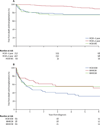Risk stratification at diagnosis for children with hypertrophic cardiomyopathy: an analysis of data from the Pediatric Cardiomyopathy Registry
- PMID: 24011547
- PMCID: PMC4007309
- DOI: 10.1016/S0140-6736(13)61685-2
Risk stratification at diagnosis for children with hypertrophic cardiomyopathy: an analysis of data from the Pediatric Cardiomyopathy Registry
Abstract
Background: Treatment of children with hypertrophic cardiomyopathy might be improved if the risk of death or heart transplantation could be predicted by risk factors present at the time of diagnosis.
Methods: We analysed data from the Pediatric Cardiomyopathy Registry, which collected longitudinal data for 1085 children with hypertrophic cardiomyopathy from 1990 to 2009. Our goal was to understand how patient factors measured at diagnosis predicted the subsequent risk of the primary outcome of death or heart transplantation. The Kaplan-Meier method was used to calculate time-to-event rates from time of diagnosis to the earlier of heart transplantation or death for children in each subgroup. Cox proportional-hazards regression was used to identify univariable and multivariable predictors of death or heart transplantation within each causal subgroup.
Findings: The poorest outcomes were recorded for the 69 children with pure hypertrophic cardiomyopathy with inborn errors of metabolism, for whom the estimated rate of death or heart transplantation was 57% (95% CI 44-69) at 2 years. Children with mixed functional phenotypes also did poorly, with rates of death or heart transplantation of 45% (95% CI 32-58) at 2 years for the 69 children with mixed hypertrophic and dilated cardiomyopathy and 38% (95% CI 25-51) at 2 years for the 58 children with mixed hypertrophic and restrictive cardiomyopathy. For children diagnosed with hypertrophic cardiomyopathy at younger than 1 year, the rate of death or transplantation was 21% (95% CI 16-27) at 2 years. For children diagnosed with hypertrophic cardiomyopathy and a malformation syndrome, the rate of death or transplantation was 23% (95% CI 12-34) at 2 years. Excellent outcomes were reported for the 407 children who were diagnosed with idiopathic hypertrophic cardiomyopathy at age 1 year or older, with a rate of death or heart transplantation of 3% (95% CI 1-5) at 2 years. The risk factors for poor outcomes varied according to hypertrophic cardiomyopathy subgroup, but they generally included young age, low weight, presence of congestive heart failure, lower left ventricular fractional shortening, or higher left ventricular end-diastolic posterior wall thickness or end-diastolic ventricular septal thickness at the time of cardiomyopathy diagnosis. For all hypertrophic cardiomyopathy subgroups, the risk of death or heart transplantation was significantly increased when two or more risk factors were present and also as the number of risk factors increased.
Interpretation: In children with hypertrophic cardiomyopathy, the risk of death or heart transplantation was greatest for those who presented as infants or with inborn errors of metabolism or with mixed hypertrophic and dilated or restrictive cardiomyopathy. Risk stratification by subgroup of cardiomyopathy, by characteristics such as low weight, congestive heart failure, or abnormal echocardiographic findings, and by the presence of multiple risk factors allows for more informed clinical decision making and prognosis at the time of diagnosis.
Funding: US National Institutes of Health and Children's Cardiomyopathy Foundation.
Copyright © 2013 Elsevier Ltd. All rights reserved.
Conflict of interest statement
The authors declared no conflicts of interest
Figures


Comment in
-
Paediatric cardiomyopathy: getting to the heart of the matter.Lancet. 2013 Dec 7;382(9908):1866-7. doi: 10.1016/S0140-6736(13)61799-7. Epub 2013 Sep 3. Lancet. 2013. PMID: 24011546 No abstract available.
-
Cardiomyopathy in children: importance of aetiology in prognosis.Lancet. 2014 Mar 1;383(9919):781-2. doi: 10.1016/S0140-6736(14)60400-1. Lancet. 2014. PMID: 24581663 No abstract available.
-
Cardiomyopathy in children: importance of aetiology in prognosis--authors' reply.Lancet. 2014 Mar 1;383(9919):782-3. doi: 10.1016/S0140-6736(14)60401-3. Lancet. 2014. PMID: 24581664 No abstract available.
References
-
- Richardson P, McKenna W, Bristow M, et al. Report of the 1995 World Health Organization International Society and Federation of Cardiology Task Force on the definition and classification of cardiomyopathies. Circulation. 1996;93:841–842. - PubMed
-
- Maron BJ, Tajik AJ, Ruttenberg HD, et al. Hypertrophic cardiomyopathy in infants: clinical features and natural history. Circulation. 1982;65:7–17. - PubMed
-
- Suda K, Kohl T, Kovalchin JP, Silverman NH. Echocardiographic predictors of poor outcome in infants with hypertrophic cardiomyopathy. Am J Cardiol. 1997;80:595–600. - PubMed
-
- Schaffer MS, Freedom RM, Rowe RD. Hypertrophic cardiomyopathy presenting before 2 years of age in 13 patients. Pediatr Cardiol. 1983;4:113–119. - PubMed
-
- Bruno E, Maisuls H, Juaneda E, Moreyra E, Alday LE. Clinical features of hypertrophic cardiomyopathy in the young. Cardiol Young. 2002;12:147–152. - PubMed
Publication types
MeSH terms
Grants and funding
LinkOut - more resources
Full Text Sources
Other Literature Sources

